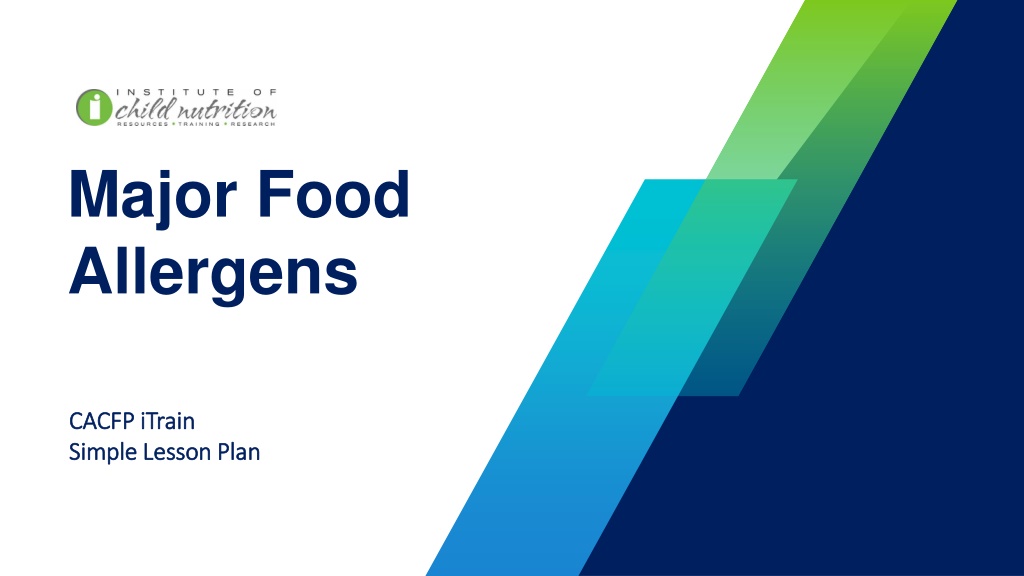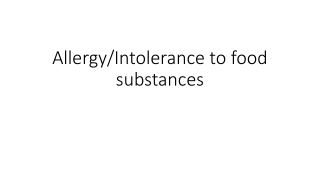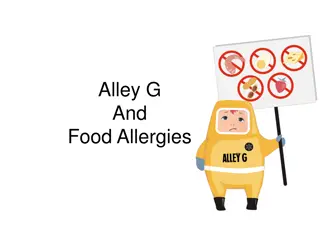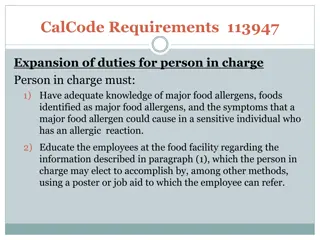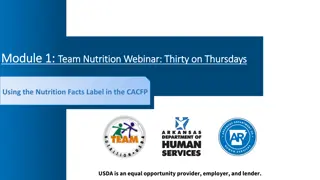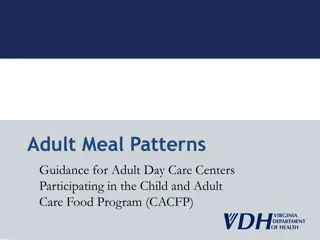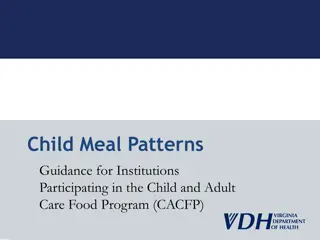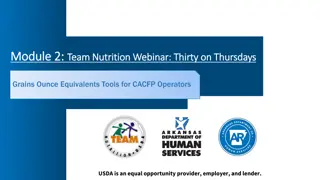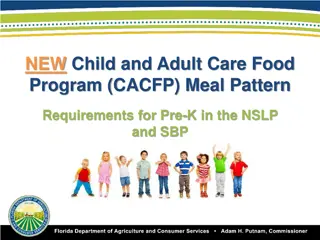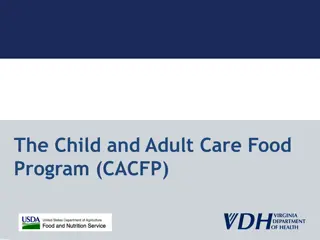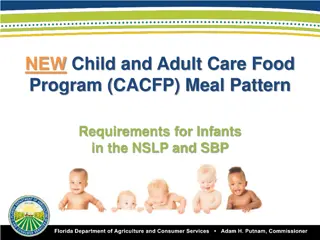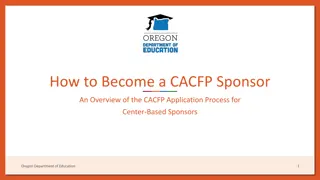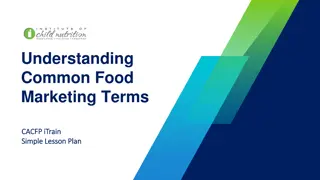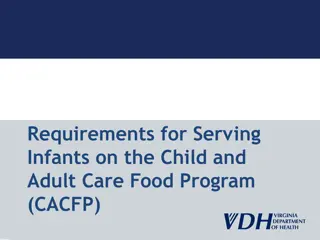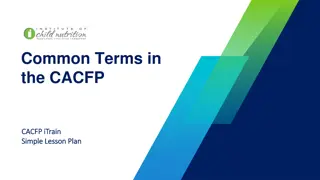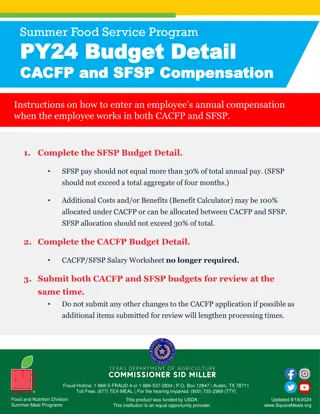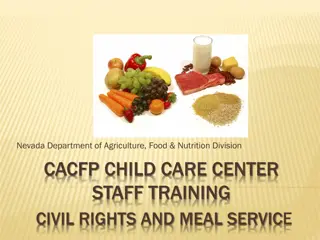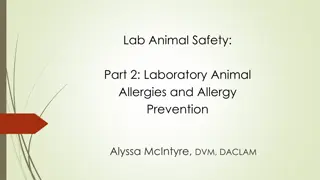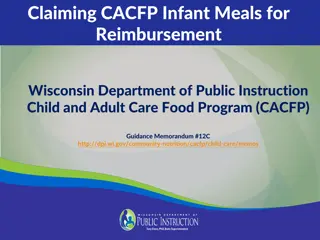Understanding Common Food Allergens in CACFP
Delve into the identification of major food allergens in CACFP settings through this lesson plan. Explore common allergens like milk, soy, eggs, fish, wheat, shellfish, peanuts, sesame, and tree nuts. Learn how to read ingredient statements to detect allergens and understand the sources of allergens in everyday foods. Enhance your awareness of food allergies to create a safe environment for children with dietary restrictions.
Download Presentation

Please find below an Image/Link to download the presentation.
The content on the website is provided AS IS for your information and personal use only. It may not be sold, licensed, or shared on other websites without obtaining consent from the author. Download presentation by click this link. If you encounter any issues during the download, it is possible that the publisher has removed the file from their server.
E N D
Presentation Transcript
Major Food Allergens CACFP CACFP iTrain Simple Lesson Plan Simple Lesson Plan iTrain
Introduction Introduction Trainer and Participants Introductions
Review Current Knowledge Review Current Knowledge Do you have any children in your CACFP Do you have any children in your CACFP center with food allergies? What foods are center with food allergies? What foods are they allergic to? they allergic to?
Overview Overview
Lesson Objective Lesson Objective Identify the nine common allergens.
Common Food Allergens Common Food Allergens Milk Soy Eggs Fish Wheat Shellfish Peanuts Sesame Tree nuts
Reading Ingredient Statements Reading Ingredient Statements Check every label, every time you purchase and prepare food Allergens found in many foods Manufacturers required to list ingredients and presence of the nine major food allergens on the label With the exception of sesame which is not required to be listed until January 2023
Milk Milk Milk allergens come from the protein in whole, 2%, 1%, and skim, cream, yogurt, cheese, ice cream Less obvious milk ingredients: Casein Curds Ghee Lactose Butter whey
Eggs Eggs Both the whites and yolks can be an allergen. Some common names on food labels: Albumin (also spelled albumen) Egg (dried, powdered, solids, white, and yolk) Eggnog Lysozyme Mayonnaise Meringue (meringue powder) Ovalbumin Surimi
Wheat Wheat Wheat sources include bread, rolls, pastry, cookies, cake, and cereal made with wheat. Whole grain and refined wheat both cause allergic reactions. Some unexpected sources of wheat are processed meats, rice cakes, salad dressings, sauces, and soups.
Peanuts Peanuts Stand alone as a major allergen Avoid foods that contain peanuts or any of peanut by-products
Tree Nuts Tree Nuts Pine nuts Cashews Chestnuts Pistachios Hazelnuts Pecans Brazil nuts Walnuts Almonds
Soy Soy Soy is added to many foods as a way to add protein or enhance flavor.
Fish Fish Fish from both fresh water and the sea cause allergic reactions in some children. Avoid fish oil and fish sticks Some unexpected sources of fish: Barbecue sauce Caesar dressing Imitation/artificial fish or shellfish (e.g., Surimi, also known as sea legs or sea sticks ) Worcestershire sauce
Shellfish Shellfish Separated from fish as an allergy group Some children can eat fish but not shellfish Avoid foods that contain shellfish or any of these ingredients: Barnacle Crab Crawfish (crawdad, crayfish, and crevisse) Krill Lobster (langouste, langoustine, moreton bay bugs, scampi, and tomalley) Prawns Shrimp (crevette, scampi)
Sesame Sesame Usually found in foods in the form of seeds or oil A protein found in sesame causes an allergic reaction
Activity Activity Nine Common Allergens
Conclusion Conclusion
Lesson Conclusion Lesson Conclusion Nine major allergens create the majority of allergic reactions in children. milk, eggs, wheat, peanuts, tree nuts, soy, fish, shellfish, and sesame Several allergens can be found in the same menu item. Read labels carefully for allergens every time you purchase and prepare the food! Allergic reactions can be created with a large amount or a very small amount of the allergen. Remember that while this training only covers the nine major allergens, other foods can cause allergic reactions in children.
Activity Activity Speed Action Planning
Thank You! Thank You! The University of Mississippi The University of Mississippi School of Applied Sciences School of Applied Sciences www.theicn.org www.theicn.org 800 helpdesk@theicn.org helpdesk@theicn.org 800- -321 321- -3054 3054 Follow ICN on Social Media! Follow ICN on Social Media! Logo Pinterest Logo Logo Logo Facebook Twitter Instagram @ichildnutrition instagram.com/theicn pinterest.com/theicn facebook.com/ichildnutrition
